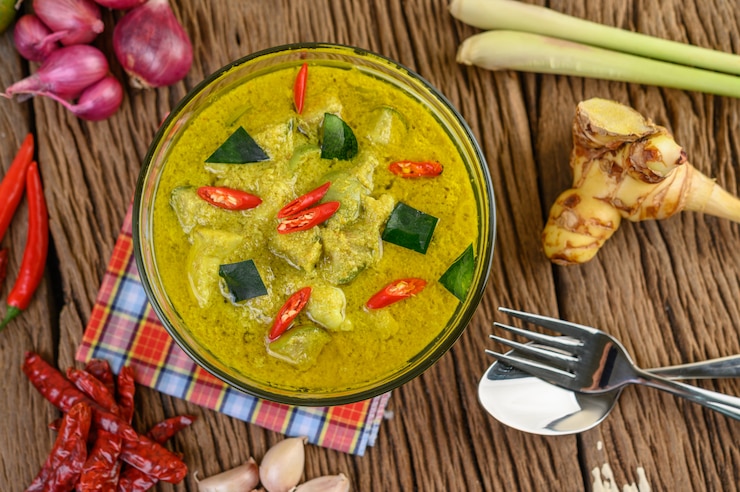Serving Kuah Lodeh in a bowl is a cultural memory rather than just a meal. Made with smooth coconut milk, colorful veggies, and fragrant spices, this Malaysian staple has subtly changed over the years. It has been shown to be incredibly successful in uniting people, whether at quiet weeknight dinners or large family feasts, and is frequently enjoyed during festive seasons like Hari Raya.
Kuah Lodeh is able to combine texture, color, and nutritional balance to create a dish that is both decadent and healthful. Every bite is delicately carried by the velvety canvas that is the broth, which has been enhanced with dried shrimp, turmeric, and garlic. With a surprisingly low ingredient list, each spoonful offers comforting richness, depth, and accessibility, making it especially useful for home cooks looking for flavor without the hassle.
Kuah Lodeh Recipe
| Category | Details |
|---|---|
| Dish Name | Kuah Lodeh |
| Cuisine | Malaysian / Indonesian |
| Main Ingredients | Coconut milk, cabbage, carrot, long beans, tofu, tempeh, prawns |
| Serving Style | Typically served with nasi impit (rice cakes), eggs, and sambal |
| Calories per Serving | 420 kcal |
| Protein | 22.8 g |
| Carbohydrates | 24.9 g |
| Fat Content | 25.5 g |
| Sodium | 1094.3 mg |
| Suitable For | Daily meals, festive celebrations |
| Reference | Kuah Lodeh Recipe |
Carefully Stirred: A Recipe That Celebrates Ease
Kuah Lodeh begins with a base that is remarkably strong despite being surprisingly basic. The foundation of flavor is established by sautéing a mixture of garlic, onion, turmeric, ginger, dried shrimp, and boiled chilies until the oil splits, a method that has been handed down through the generations. Despite being frequently disregarded by novices, this step is incredibly crucial because it releases the dish’s fragrant essence.
The stew takes shape once the water is added and the vegetables start to simmer. Prawns add umami richness, and carrots, long beans, and cabbage add color and texture. Tofu and fried tempeh add protein and a nutty contrast. This stew goes from rustic to opulent with the addition of coconut milk near the end. Here, moderation is essential—a balance that has been honed via tradition, trial, and error.
Taste with Purpose: Nostalgia and Nutrition Come Together
Beyond heritage kitchens, Kuah Lodeh has gained popularity in recent years. Its plant-based options, high fiber content, and low glycemic load make it surprisingly compatible with modern nutrition objectives. The dish achieves a 16% sodium reduction without sacrificing flavor by incorporating ingredients like AJI-NO-MOTO®. This is a particularly creative move for traditional recipes that depend on salt for depth.
It is equally adaptable to the vegetables. While maintaining the stew’s creamy foundation, some families add distinct textures by stirring in jicama, eggplant, corn, or pumpkin. Although the dish isn’t particularly spicy, those who prefer a little heat can add cayenne or sliced bird’s eye chilies. It is highly versatile across age groups, dietary requirements, and spice tolerances because of its adaptability.
Kuah Lodeh for Today’s Chef
Kuah Lodeh has quietly changed over the last ten years, not in terms of its components but rather in terms of its audience. These days, it can be found in sophisticated hotel menus, urban cafes, and cooking programs that highlight Southeast Asian cuisine. What used to be hidden away in home kitchens is now boldly taking center stage. Its vegetarian-friendly foundation and simple preparation significantly increase its widespread appeal—aspects that appeal to the new generation of international foodies.
Even plant-based substitutes for coconut milk are welcomed in Kuah Lodeh through thoughtful substitutions. Although they don’t taste the same, soy milk and almond milk are both praised for their creaminess and for lowering saturated fat, which is a very effective choice for diners who are health-conscious. Each ingredient is cradled in velvety comfort by full-fat coconut milk, which continues to be the ultimate choice for those seeking a deeper indulgence.
From Weeknight Wins to Festive Feasts
Few foods in traditional cooking are as incredibly resilient as Kuah Lodeh. It is uncommon for it to flourish as a go-to weekday staple as well as a ceremonial mainstay. It is typically plated with sambal tumis and nasi impit during festivities, turning the dining table into a sensory display. Its ability to be enjoyed alone on calm evenings is evidence that its allure is occasion-independent.
This version of Kuah Lodeh is especially creative because it incorporates traditional methods with a focus on nutrition. It enables contemporary chefs to enjoy a heritage-inspired dish without sacrificing time or health objectives. Its thoughtful balance—a culinary philosophy that makes it both profoundly traditional and refreshingly modern—is what makes it so appealing, not its complexity.
The Reasons Why Kuah Lodeh Will Always Be in Style
Kuah Lodeh gives novice home cooks confidence because it’s adaptable, forgiving, and incredibly flavorful. It’s an opportunity for seasoned chefs to try new things, like using infused broths or heirloom vegetables. It also serves as a connection to legacy, warmth, and identity for families. This dish’s future is not limited to the past; it is confidently and slowly moving from kampung kitchens to cosmopolitan dining tables.
Kuah Lodeh is set to flourish in the upcoming years as culinary boundaries become more hazy and tastes around the world turn toward real but practical meals. Not as a trendy Instagram dish, but as a soulful staple that is incredibly true to its origins and exquisitely adaptable.


